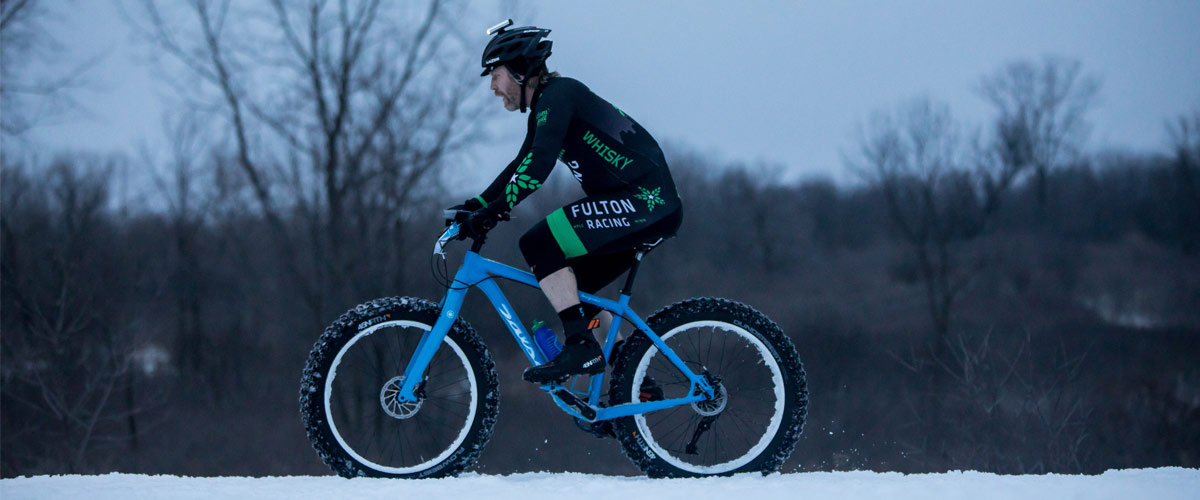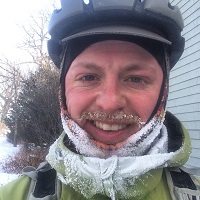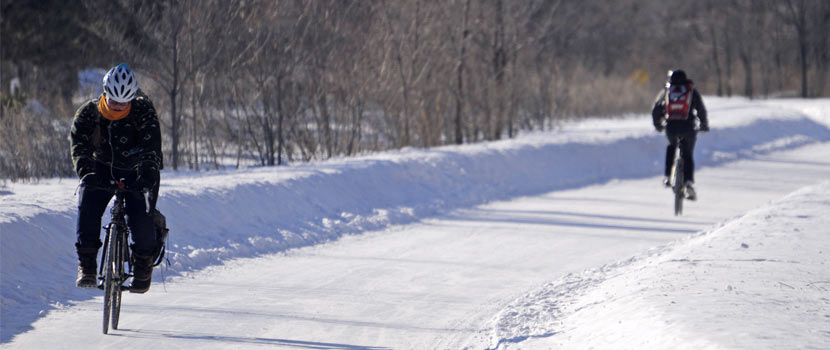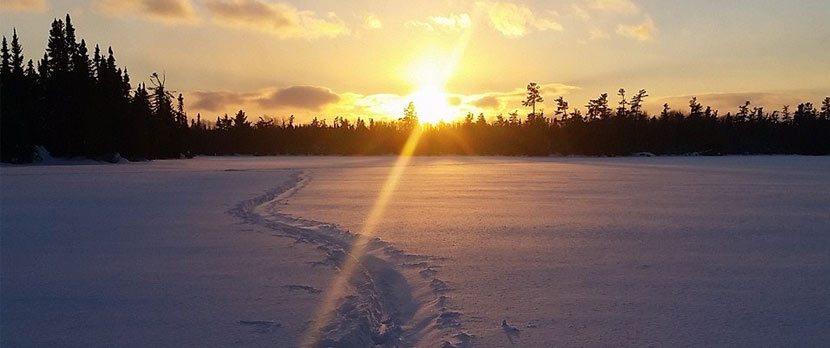
Biking year-round is an integral part of my life as a Minnesotan. Bike riding is my main form of transportation, exercise, entertainment, socializing, and perhaps most importantly, a key component in my emotional health and wellbeing. I would love for bike riding to be the same for others.
I think many people have similar views and experiences about biking in warm, dry weather but fewer seem to share this interest when it gets cold, wet, dark, and snowy. There are countless barriers (both perceived and actual) that prevent people from biking in the winter.
Ultimately, most of us already have much of the gear that makes winter biking comfortable, practical, fun, and safe. Below are some tips that help me overcome winter conditions and make winter biking seem less daunting.
LET’S TALK TIRES
Although sometimes (rarely) studded tires and/or a fat bike is your best option, in general these specific tires are not needed for winter biking in the Twin Cities. Chances are there is a good option regardless of what bike or wheels you have. That tire may simply be the existing tire; a wider, knobbier or stronger gripping tire; a studded tire designed to tackle ice and prevent falls; or a winter-specific but non-studded tire.
Some basics to keep in mind:
“Skinny” with Knobs
- Pros: Slice through snow and slush, sometimes contact the grippier road or path, fastest option, and generally the cheapest in this list.
- Cons: Less confidence-inspiring for big bumps, super deep snow and ice.
- Notes: Hybrid, gravel, cyclocross, city, and winter non-studded tires fall in this category.
Standard Mountain Bike
- Pros: Easily roll over potholes and chunks of snow, easier to pedal than fat bikes, and knobs give some extra grip in slippery areas.
- Cons: Don’t slice through snow like a skinnier tire or float like a fat bike, and sometimes feel like they just push snow.
- Notes: Old mountain bikes are a popular option for winter commuter or beater bikes.
Fat Bike
- Pros: Maximum float and grip for deeper snow, can “go anywhere” and “run over anything,” and can ride on singletrack mountain bike trails.
- Cons: Expensive, do not fit on bus bike racks, and slow.
- Notes: Fat bike tires do not grip on ice unless they have studs.
Studded Tires of Any Size
- Pros: Traction on ice and more confidence-inspiring on days that could have ice.
- Cons: Expensive, very loud, and wear out if used too much on pavement.
- Notes: Some people use a studded tire only in the front to help with turns, while others leave studded tires on a spare wheel set to make it easier to choose studs when the conditions are right.
In addition, slightly lower tire pressure on any bike can add some grip and traction by increasing the surface area of the rubber in contact with the ground.
KEEPING WARM
Factors for a safe, comfortable winter bike ride are very dynamic. Everybody’s comfort level and ability to stay warm but not-too-warm is different. Below are some conditions to consider and what works for me to stay comfortable.
AIR TEMPERATURE
Chilly (20°F-40°F)
It is easy to overheat at this temperature and then quickly get cold. I like a thin, wool base layer (synthetic works great, too!) under a breathable, softshell jacket with venting zippers under the arms or on the chest that dump heat as it builds up.
If it is not too wet and I am not using a backpack, I may choose thicker but more breathable fleece, wool or synthetic mid-layers instead and add a wind-blocking vest if it’s windy. I’ll add thin long underwear under my pants when it is around 25°F or 30°F.
A runner’s headband or thin skull cap keep my ears and head comfy; a medium-weight pair of gloves or thin mittens keep my hands warm. I also usually wear a thin buff or neck warmer.
Kind of Cold (5°F-20°F)
These are my favorite temperatures for winter riding. It is hard to overheat but not bone-chillingly cold. I follow the same layering guidelines listed above but wear thicker mittens and boots and perhaps a slightly thicker base layer.
Pretty Cold (<5°F)
The biggest change for staying comfortable at near or below zero temperatures is to cover your skin! Protect your cheeks and nose with buffs, scarves, face masks, and (my new favorite) Chapstick or Vaseline. Some people like goggles.
Keep your core warm and consider adding an extra layer around your hips and seat area; your upper legs, stomach, and areas with extra nerve endings can get pretty cold even when the rest of your body is comfortable.
Wear warm mittens with an extra liner or use hand warmers or pogies (big, insulated pockets/mittens around your handlebars). Bring an extra pair of socks and do not wear too many socks at once because toes need airspace to move and stay warm.
WIND CHILL AND DIRECTION
Wear a breathable but wind-blocking layer when it is windy and cold. Cover more skin when the wind chill is severe but anticipate removing layers if you are biking into a headwind due to increased exertion.
A wind-blocking vest provides almost as much protection as a full jacket but provides more breathability and a lower chance of overheating or sweating too much.
MOISTURE
Staying dry is huge. Overheating leads to sweating which leads to getting super cold. Fleece, waxed canvas, and wool layers are helpful materials to stay dry and comfortable because they breathe but can still handle some snow or splashes from the road. Having dry layers to change into in the middle of a long ride or upon arriving at your destination is a game changer!
Wet snow can be as saturating as rain so make sure you have a water-repellent or waterproof jacket if you ride in these conditions. Slush and puddles are common in the winter; fenders and waterproof boots can help.
LENGTH OF RIDE
Less than 15 Minutes
These rides are short enough that you can wear enough layers to start warm without worrying about overheating or sweating. Most cold-weather safety concerns like frostbite and hypothermia can be avoided with common sense.
15–45 Minutes
This length of ride gives your body enough time to warm-up, so it is important to start a bit cold or stop to unzip or delayer mid-ride to avoid overheating and sweating too much.
45+ minutes
Riding for longer than 45 minutes can be tricky because of moisture build-up, especially in your feet. A synthetic, wicking sock under a wool sock can help manage this moisture and keep feet warm; I sometimes change socks mid-ride in really cold weather. Warm your feet by getting off your bike and running in circles or doing jumping jacks. Wind milling your arms helps warm chilly fingers. Sometimes a break inside is necessary, too.
SUN AND LESS DAYLIGHT
A cold day feels colder when it’s cloudy and dreary as well as after the sun sets. In addition, bright sun on white snow can be blinding so consider wearing sunglasses or goggles. Days are shorter and bikers are less common in winter so lights and reflective gear are important safety accessories.
FINDING WHAT WORKS FOR YOU
What works for me may not be quite perfect for you, but with minor adjustments, you will quickly find what makes you feel comfortable on a bike ride in the winter.
If biking is something you enjoy in the milder months, don’t give it up just because it’s winter! Whether you ride to the neighbor coffee shop on local streets, commute on bike paths to work, or fat bike on a singletrack mountain bike trail in Three Rivers, these tips are a good starting place for winter riding and hopefully help give you the confidence to give it a try. If you need further inspiration, read my top 5 reasons for bike commuting year-round.
Feel free to email me, ask your local bike shop, or reach out to your community for additional advice on gear, your bike, and riding in wintry conditions.
About the Author

Anders Hanson is an Interpretive Naturalist at Mississippi Gateway Regional Park and helps the Outdoor Recreation School with mountain bike camps and races. Anders graduated from Luther College with a degree in biology and environmental studies and a minor in secondary education. He has worked for Three Rivers Park District for over six years, including in Wildlife/Natural Resources Management and at Richardson Nature Center, Baker Near-Wilderness Settlement, and Silverwood Park. He grew up close to and spent much of his childhood exploring Hyland Lake Park Reserve. When not at work, he likes to mountain bike, camp, see live music, and travel.
Related Blog Posts
My Top 5 Reasons to Bike Commute Year-round (Yes, Even in Winter)
By: Anders Hanson
The arrival of winter is often associated with a decrease in the amount of time spent being active outside. Learn five reasons why you should consider bike commuting as a way to spend more time outdoors and embrace our coldest season.
Embracing Winter: How to Get Comfortable with the Cold
By: Erin Korsmo
Why should we be outside in the winter? Learn the benefits of getting outdoors and how to be outside comfortably in the cold, and find inspiration for embracing winter this season.
My #OptOutside Top 5
By: Jessica Allen
#OptOutside is a movement started by REI that encourages people to opt for outdoor adventures in lieu of Black Friday shopping. Find more on the mindset of #OptOutside and how to incorporate it into your daily life.



